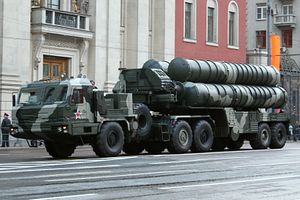India’s Cabinet Committee on Security (CCS), the country’s highest government body responsible for defense procurement and final arbiter on national security issues headed by Indian Prime Minister Narendra Modi, has quietly cleared the last hurdle for the intended acquisition of five regiments of Russian-made S-400 Triumf air defense systems (NATO reporting name: SA-21 Growler) last week, according to government sources.
The CCS purportedly cleared the purchase of the five S-400 regiments on September 26, The Times of India reports paving the way for the signing of a sales contract at a summit meeting between Indian Prime Minister Narendra Modi and Russian President Vladimir Putin scheduled for October 5. As of October 1, however, the Indian government has not publicly confirmed that the CCS approved the $5.5 billion acquisition.
India is expected to receive the first S-400 regiment two years after the signing date of the contract. Russian state-owned arms maker Almaz-Antey reportedly expects a 15 percent down payment upon the conclusion of the deal this week. Notably, according to a defense source speaking to The Hindustan Times, the contract will not contain an offset clause in order to expedite delivery of the S-400 air defense systems.
“They [Russia] agreed for offsets later, but we decided not to include them as it would drive up the cost and delay deliveries,” the source said last week. New Delhi and Moscow concluded an inter-governmental agreement for the purchase of the S-400s in 2016 (See: “India and Russia Ink S-400 Missile Air Defense System Deal”).
The S-400 is one of world’s most advanced interceptor-based long-range air defense systems capable of firing a variety of different missiles including the 40N6 SAM (the export variant of the missile is designated 40N6E) estimated to have an operational range of 400 kilometers (248.5 miles) and capable of hitting targets at a maximum altitude of 30 kilometers.
Meanwhile, the United States and India continue to discuss Washington’s threat to impose economic sanctions on New Delhi should it proceed with the S-400 procurement as a result of the Countering America’s Adversaries Through Sanctions Act (CAATSA) which came into effect in January 2018.
“The U.S. law decrees the imposition of mandatory economic sanctions on countries importing Russian military hardware,” I explained earlier this month. “However, this year’s U.S. National Defense Authorization Act (NDAA) grants the Trump administration authority to waive mandatory sanctions under CAATSA in certain circumstances pertaining to Russian legacy systems that costs less than $15 million.”
So far, the two countries have not reached an agreement.
Last month the United States imposed sanctions on the People’s Liberation Army’s (PLA) Equipment Development Department (EDD) for the procurement of S-400 systems and Sukhoi Su-35S (NATO reporting name: Flanker-E) fourth generation, twin-engine, multirole fighter aircraft.
However, given that China was sanctioned not so much for signing the sales contract with Russia in 2015 but more so because it took delivery of the S-400s and fighter aircraft earlier this year and in 2017, it appears unlikely that the U.S. will immediately impose sanctions upon the conclusion of an Indo-Russian contract on October 5.
































